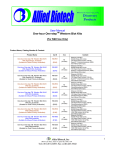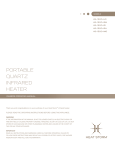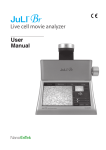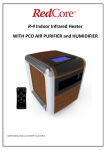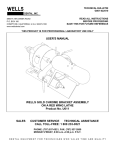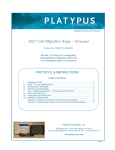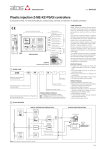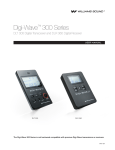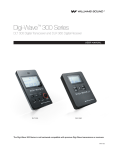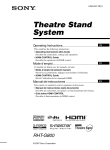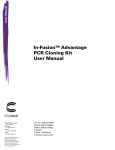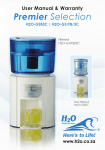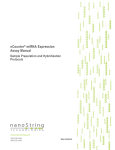Download User Manual Universal One
Transcript
User Manual UniversalTM One-step Western Blot Kits (For R&D Use Only) I. Product Name, Catalog Number & Content: Product Name CB Cat # Size Content Enhancer (100 ML) 50XWB Probe-R51 (2 ML) 10X Rapid Wash Solution (100 ML) SuperHi™ Chemiluminescence (40ML) Enhancer (100 ML) 50XWB Probe-M51 (2 ML) 10X Rapid Wash Solution (100 ML) SuperHi™ Chemiluminescence (40ML) Enhancer (100 ML) 50XWB Probe-G51 (2 ML) 10X Rapid Wash Solution (100 ML) SuperHi™ Chemiluminescence (40ML) UniversalTM One-step Western Blot Kit-R With SuperHi Chemiluminescence (Suitable for Rabbit Primary Antibodies) WB-R51 Kit (10 tests) UniversalTM One-step Western Blot Kit-M With SuperHi Chemiluminescence (Suitable for Mouse Primary Antibodies) WB-M51 Kit (10 tests) UniversalTM One-step Western Blot Kit-G With SuperHi Chemiluminescence (Suitable for Goat Primary Antibodies) WB-G51 Kit (10 tests) One-step Western Blot Kit-R With DAB Substrate (Suitable for Rabbit Primary Antibodies) WB-R50 Kit (10 tests) Enhancer (100 ML) 50XWB Probe-R50 (2 ML) 10X Rapid Wash Solution (100 ML) 100X DAB Solution Set (2 ML) UniversalTM One-step Western Blot Kit-M With DAB Substrate (Suitable for Mouse Primary Antibodies) WB-M50 Kit (10 tests) Enhancer (100 ML) 50XWB Probe-M50 (2 ML) 10X Rapid Wash Solution (100 ML) 100X DAB Solution Set (2 ML) WB-G50 Kit (10 tests) Enhancer (100 ML) 50XWB Probe-G50 (2 ML) 10X Rapid Wash Solution (100 ML) 100X DAB Solution Set (2 ML) TM Universal TM Universal One-step Western Blot Kit-G With DAB Substrate (Suitable for Goat Primary Antibodies) II. Product Description: IV. Features: TM Universal One-Step Western Blot Kit (patent pending) is an innovative and• Easy: a simple one-step reaction (a regular procedure needs 4 steps: blocking, 1st antibody-binding, washing and 2nd antibody-binding). the most advanced Western blot kit. With the kit, your Western blot will be no longer a time-consuming and labor-intensive procedure. The procedure • Rapid: the whole procedure takes less than one hour (a regular immuno-blot takes 3~5 hrs). of a typical (regular) Western blot contains seven steps (blocking, washing, primary antibody-binding, washing, secondary antibody-binding, washing, • Universal: suitable for most primary antibodies. and developing) and requires 4~5 hours. In contrast, the procedure of • Sensitive: comparable sensitivity with regular immuno-blot. TM Universal One-Step WB only contains: one-reacting, washing, and • Reusable: antibodies and reagents can be reused. developing, and requires as short as 60 minutes. Currently, we provide • Re-stainable: membrane can be re-blotted with different antibodies. TM different types of Universal One-step WB kit as shown on the above table. • Reproducible: result is highly reproducible. Each kit is sufficient for detecting 10 (without reuse) to 40 (if reused) mini gel-size membranes. V. Storage: III. Application (for R&D use only): TM Rapid Immuno-blot (Western-blot and Dot-blot) for: • Rapidly identifying a specific protein either purified or unpurified. • Rapidly detecting a specific protein expressed in cells. • Rapidly monitoring a target protein in a purification procedure (just needs 1-2μl of sample). • Rapidly semi-quantifying a specific protein (just needs 2μ of sample). • Rapidly screening or titrating antigen-specific antibodies. • All reagents in Universal One-Step Western Blot Kits can be stored at refrigerator (2~8 °C) except that WB probe and DAB solution must be stored at –20 °C. Expiration date: 6 months from the date of receipt if properly stored. Rapid Wash Solution can be stored at room temperature for 1 year. • Note: Kit may be shipped in ambient temperature. 1 Tel: (201)-882-2593 Fax: (201)-882-2593 www.columbia-bio.com VI. Comparison of One-step WB with Regular WB: i. One-step Procedure: 1). One-Reaction: Add 10ml of Enhancer (supplied in the kit) and Westerntransferred (or dot-blotted) membrane to a proper container, gently shake the container to wet both sides of the membrane (Note: the membrane must be fully wetted by Enhancer before adding Ab). Mix 5ug of primary antibody with 200ul of 50XWB Probe (supplied in the kit), then add this mixture to the container, mix well and continue shaking for 30-90 minutes (longer incubation may needed if the specific affinity of primary Ab is weak or if less amount of primary Ab is used) at room temperature. 2). Wash: Follow the Wash step under Common Procedure (see below). 3). Development: Follow the Development step under Common Procedure (see below). VII. Protocol: I. Additionally required materials (not supplied in the kit) : • Primary antibody: Purified high affinity IgG antibodies (either polyclonal or monoclonal) are preferred. Although unpurified antibody or serum is also suitable for the kits, user may need to optimize the concentration of antibody or select a different procedure (see Table of Procedure Guide below). • Note: All Kits are labeled with ” –R”, “-M” and “-G’ suitable for only Rabbit, Mouse and Goat primary antibodies respectively. User must pay attention to select right primary antibody to match different type kit. • Western-blot Membrane: Both Nitrocellulose and PVDF membrane are suitable for One-step WB. User must perform PAGE and Westerntransferring ahead of using this protocol. • X-ray film & its related reagents (required only if Chemiluminescent substrate is used): Sensitive X-ray films are preferred. X-ray film developing related reagents (excluding Chemiluminescence) and apparatus (such as film cassettes and developer trays or auto-filmdeveloping machine) are also required. • 1% BSA in PBS buffer (optional0. Needed only when Two-step Procedur-B or Three-step Procedure is selected (see the procedure below for details). II. Procedure: TM Universal One-Step Western Blot Kits are designed for One-step Procedure but also compatible with Two-step and Three-step procedures. A proper procedure must be selected according to the quality of primary antibody to be used and the quality of result expected. The following table provides a basic guide for selecting a proper procedure to obtain expected result: Table of Procedure Guide: 1-step Procedure 2-step-A Procedure 2-step-B Procedure 3-step Procedure 1. Soak with 1. Soak with Enhancer; 1. Soak with Enhancer + 1st Enhancer; 2. 1st Ab Ab; incubate; 2. 1st Ab + 2. Probe 3. Probe Probe incubate. incubate. incubate. Step(s) before wash for development 1. Onereaction. Average Time 60 min 110 min Requirement for primary Ab. Purified / high affinity Background Light ~ low Purified / high Any affinity Light ~ very Very low low Sensitivity High High 110 min 155 min Any Very low Moderate~ Moderate~ highest highest depending on Ab depending on Ab quality quality Tips A: 1. The optimal amount (1-10ug/10ml in most cases) of primary antibody used in One-step WB might be different from that used in a regular WB and is highly depending on its purity and affinity, therefore to obtain best results, a simple antibody titration using One-step Dot Blot is recommended. 2. The membrane must be fully covered by the solution during shaking. 3. Extend incubation time for an additional 15 min if cold WB Enhancer is used before warming to room temperature. 4. For convenience, any step (soaking or antibody binding) can be left overnight at o 4 C. 5. If desired, recover the used Reaction Mixture (consisting of WB Enhancer, primary antibody/Probe) and store at 2-8 °C (for up to 1 weeks) or -20 °C (for 3 months or longer storage); This One-Reaction Mixture can be subsequently reused 3-4 times for testing the same antigen (It may be required to add additional amount of primary antibody to compensate for the loss at each usage). ii. Two-step-A Procedure: 1). Enhancer-soaking: To a proper container, add 10ml of Enhancer (supplied in the kit) and Western-transferred (or dot-blotted) membrane; gently shake at room temperature for 30-60 minutes. 2). Primary Ab + Probe Incubation: Mix 5ug of primary antibody with 200ul of 50XWB Probe (supplied in the kit), then add this mixture to the above container, mix well and continue shaking for 40-90 minutes (longer incubation may needed if the specific affinity of primary Ab is weak or if less amount of primary Ab is used) at room temperature (Read Tips A above). 3). Wash: Follow the Wash step under Common Procedure (see below). 4). Development: Follow the Development step under Common Procedure (see below). iii. Two-step-B Procedure: 1). Enhance +1st Ab-Soaking: Add 10ml of Enhancer (supplied in the kit) and Western-transferred (or dot-blotted) membrane to a proper container, gently shake the container to wet both sides of the membrane (Note: the membrane must be fully wetted by Enhancer before adding Ab), add 5ug of primary antibody to the container, mix well and continue shaking for 40-90 minutes (longer incubation may needed if the specific affinity of primary Ab is weak or if less amount of primary Ab is used) at room temperature (Read Tips A above). 2). Probe Incubation: Rinse the membrane twice with plenty of distilled water. Mix 200ul of 50XWB Probe (supplied in the kit) with 10ml of 1%BSA in PBS, then add to the container, continue shaking for 30-60 minutes at room temperature. 3). Wash: Follow the Wash step under Common Procedure (see below). 4). Development: Follow the Development step under Common Procedure (see below). iv. Three-step Procedure: 1). Enhancer-Soaking: Add 10ml of Enhancer (supplied in the kit) and Western-transferred (or dot-blotted) membrane to a proper container, gently shake at room temperature for 30-60 minutes. 2). Primary Ab Incubation: Add 5ug of primary antibody to the container, mix well and continue shaking for 40-90 minutes (longer incubation may needed if the specific affinity of primary Ab is weak or if less amount of primary Ab is used) at room temperature (Read Tips A above). 3). Probe Incubation: Rinse the membrane twice with plenty of distilled water. Mix 200ul of 50XWB Probe (supplied in the kit) with 10ml of 1%BSA in PBS, then add to the container, continue shaking for 30-60 minutes at room temperature. 4). Wash: Follow the Wash step under Common Procedure (see below). 5). Development: Follow the Development step under Common Procedure (see below). 2 Tel: (201)-882-2593 Fax: (201)-882-2593 www.columbia-bio.com • Shake the membrane (after Chemiluminescence-developed, not suitable after DAB-developed) with 10 ml of Stripping Buffer (Cat # 238-51) for 5 min at room temperature. Recover the Stripping Buffer for reusing in future. 1. Wash: • Wash the membrane once with 10ml of PBS buffer and then rinse it with • Prepare 1X Rapid Wash Solution: Shake the bottle of 10X Rapid Wash plenty of distilled water. Solution (as it might contain precipitate) for 10 sec, then dilute the • Repeat above steps: One-Reaction (or other procedure), but using different solution to 10 times in volume with distilled water. primary antibody. Wash and Development, • Briefly rinse the membrane (from above procedure) with plenty of distilled water to remove free antibody and WB Probe. • Wash the membrane for 3-5 minutes with 30 ml of 1X Rapid Wash Solution by aggressively shaking (to remove non-specific bound VIII. Application Examples: substances); Rinse the membrane again with plenty of distilled water. • Repeat once wash and rinse (but twice if SuperHi-chemiluminescence I. Detection of GAPDH proteins in cell lysate using One-step is used for development). procedure (1 hr) comparing wit Regular WB procedure (4 hrs). v. Common Procedure: 2. Development: 1). Using SuperHi Chemiluminescence (supplied in kits: WB-R51, WB-M51 TM and WB-G51). Note: Universal One-step WB kits are compatible with most chemiluminescent substrates but detection sensitivity may vary. • Mix both 2 ml Solution A and 2 ml Solution B of chemiluminescent substrate in a proper container. • Drain excessive water on the surfaces of the washed membrane by touching one end on a clean tissue paper. Wet the membrane with the mixed substrate solution (the protein side of the membrane must be fully wetted by the solution). • Drain excessive liquid on the membrane by touching one end of the membrane on a clean tissue paper. Place the membrane (protein side up) between pre-folded transparent plastic sheets. Cover the membrane by gently pressing down the top cover sheet from one end to the other in order to eliminate bubbles and excessive substrate solution between the cover sheet and the membrane (as showed in the following picture). WB Membrane Pre-folded Transparent sheet Side view • In a dark room, place an X-ray film on the top of the covered membrane and expose for a proper time period, usually 10 seconds to 5 minutes. (It is recommended to expose multiple X-ray films for different time periods). • Develop the X-ray film in darkness or using an automatic developing machine. Tips B: 1. The pre-folded transparent plastic sheet can be easily made by cutting a commercial Transparency Sleeve to a proper size with three open sides. 2. If SaraWrap is used for covering, avoid wrinkles occurring between the top sheet and WB membrane. 3. SuperHi Chemiluminescence is a very sensitive substrate. If developed X-ray films are too dark, try one or more of the following actions to reduce background: 1) simply reduce the exposure time to as short as 1 second; 2) extensively wash the membrane for another 5 min; 3) expose X-ray film with diluted substrate solution (dilute the A & B mixture 2~3 fold with distilled water) but may need to increase exposure time; 4) strip the blot with Stripping Buffer (see Re-blot below) then re-probe the membrane with a half amount of WB Probe or/and a lower concentration of Primary Antibody. 2). Using DAB substrate (supplied in kits: WB-R50, WB-M50 and WB-G50): • Take both 100μl of 100X DAB solution and 100μl of 100X D-buffer, and mix them with 10ml of distilled water. • Incubate this DAB mixture with washed the membrane at room temperature for a proper time period, usually 3-10 minutes, till desired color blots appear. • Wash the membrane with plenty of distilled water, and then air-dry it. Upper left: One-step procedure (1 hr) with rabbit anti-GAPDH polyclonal antibodies. Upper right: Regular method (4 hrs) using rabbit anti-GAPDH polyclonal antibodies and goat anti-rabbit 2nd antibody. Lower left: One-step procedure (1 hr) with mouse anti-GAPDH monoclonal antibody. Lower right: Regular method (4 hrs) using mouse anti-GAPDH monoclonal antibody and rabbit anti-mouse 2nd antibody. Loaded cell numbers (A549 cell lysate) from lanes 1 to 6 are 10000, 3000, 1000, 300, 100 and 30 respectively. Blots were developed with Chemiluminescence. II. Rapid semi-quantification of Flag-tagged protein in purification fractions by One-step Dot Blot. Serially diluted fractions (middle, dilution factors as indicated on left side) containing Flag-tagged protein P50 and purified P50-flag as standard (right side) were dotblotted onto an NC membrane (1μl/dot), and then detected by One-step procedure using mouse anti-flag (from Sigma) and Universal One-step WB kit-M. Blots were developed with DAB. Sup: Supernatant before loading to column, Ft: Flow-through, W: Wash fraction, E1~E7: Eluted fractions 1~7. Std: Standard, purified P50-flag (blotted amount as indicated on left side). 3. Re-blot with different antibody (Optional): If needed, the membrane after development can be reused for further staining with different primary antibodies. Your valuable Westerntransferred membrane can be used efficiently with this protocol. 3 Tel: (201)-882-2593 Fax: (201)-882-2593 www.columbia-bio.com IX. Troubleshooting Guide: Problem I: X. Signal is weak or invisible. Possible Causes Too little protein was used. Solution Load more protein(s) onto the SDS-PAGE gel. Optimize transfer time and/or the electrical current. Make sure that there are no air bubbles between the membrane and gel. Check the label of you kit and select a correct Wrong type of primary primary antibody compatible with the Kit. Note: kits antibody or One-Step labeled with -R, -M and –G are suitable for using WB Kit. with rabbit, mouse and goat primary antibodies, respectively. Use high affinity and purified primary Poor binding activity of antibodies. Select 2-step Procedure-B or 3-step primary antibody. Procedure. Increase the concentration of primary antibody, or run an Antibody-Titration to optimize primary Primary antibody was antibody concentration by One-step Dot blot using diluted too much. serially diluted samples (from 1 µg/dot to 1 ng/dot) and serially diluted primary antibody. Primary antibody or Check the expiration date of the antibody as One-Step WB Kit was well as the One-step WB kit. Use fresh or defective. unexpired antibody and kit. Increase antibody-incubation time. Especially, when the amount of antigen to be detected is very Incubation time was small and the affinity of primary antibody is weak, too short or the increase incubation time to 2 hr or overnight. reagent has not been Also, if reagents stored in a refrigerator are used warmed up. before being pre-warmed to RT, longer incubation time is needed. Wash time too long. Reduce the wash time. Poor Westerntransfer. Problem II: Related Products: Columbia Bio Cat# WB-R800, WB-M800, WB-G800, WB-R700, WB-M700, WB-G700, WB-R800/M700 IHC-R60, IHC-M60, IHC-G60, IHC-R61, IHC-M61, IHC-G61 Product Name Universal TM One-step IR Western Blot Kits (For Infrared-Detection) TM Universal One-step IHC Kits with DAB or BCIP/NBT substrate TM E-R70, E-M70, E-G70, E-R71, E-M71, E-G71 Universal One-step Indirect ELISA Kits with TMB or pNPP substrate E-R80, E-M80, E-G80, E-R81, E-M81, E-G81 Universal One-step Cell-based ELISA Kits with TMB or pNPP substrate E-R90, E-M90, E-G90 Universal One-step IgG Quantifctn ELISA Kitsw/TMB TM TM High background or non-specific bands on blot. Possible Causes Solution Select high affinity antigen-specific primary antibodies. Purified monoclonal or affinity-purified Non-specific binding polyclonal primary antibodies are preferred. and cross-reactivity of Increase Enhancer-soaking time before adding primary antibody. WB Probe and primary antibody. Select 2-step or 3-step procedure. Reduce the amount of primary antibody or the Used too much amount of WB Probe for One-step Reaction. primary antibody or Optimize the amount of antibody or WB Probe by WB Probe. dot-blotting. Wash not sufficient. Increase washing time. Signal development Reduce the development time. time too long. Contaminated Use clean equipments and freshly prepared reagents or buffers. Wear gloves and use clean forceps to equipments. handle membranes. Dilute the mixed substrate solution with 1-2 volume of distilled water. Use chromogenic Signal development development reagents, such as DAB, which is less reagent too sensitive. sensitive but produce lower background than Chemiluminescent reagent. 4 Tel: (201)-882-2593 Fax: (201)-882-2593 www.columbia-bio.com




